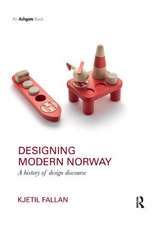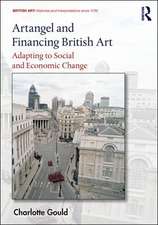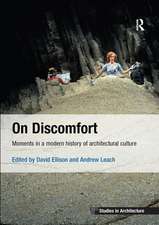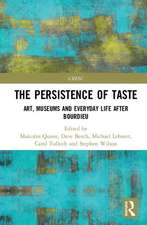Architecture and the Historical Imagination: Eugène-Emmanuel Viollet-le-Duc, 1814–1879
Autor Martin Bressanien Limba Engleză Hardback – 14 mai 2014
| Toate formatele și edițiile | Preț | Express |
|---|---|---|
| Paperback (1) | 331.39 lei 6-8 săpt. | |
| Taylor & Francis – 12 oct 2017 | 331.39 lei 6-8 săpt. | |
| Hardback (1) | 785.90 lei 6-8 săpt. | |
| Taylor & Francis – 14 mai 2014 | 785.90 lei 6-8 săpt. |
Preț: 785.90 lei
Preț vechi: 1040.14 lei
-24% Nou
Puncte Express: 1179
Preț estimativ în valută:
150.42€ • 156.44$ • 126.05£
150.42€ • 156.44$ • 126.05£
Carte tipărită la comandă
Livrare economică 14-28 martie
Preluare comenzi: 021 569.72.76
Specificații
ISBN-13: 9780754633402
ISBN-10: 0754633403
Pagini: 624
Ilustrații: Includes 86 colour and 64 b&w illustrations
Dimensiuni: 174 x 246 x 39 mm
Greutate: 1.66 kg
Ediția:New ed
Editura: Taylor & Francis
Colecția Routledge
Locul publicării:Oxford, United Kingdom
ISBN-10: 0754633403
Pagini: 624
Ilustrații: Includes 86 colour and 64 b&w illustrations
Dimensiuni: 174 x 246 x 39 mm
Greutate: 1.66 kg
Ediția:New ed
Editura: Taylor & Francis
Colecția Routledge
Locul publicării:Oxford, United Kingdom
Notă biografică
Martin Bressani is Associate Professor and Graduate Program Director at the School of Architecture, McGill University, Canada.
Recenzii
'This is a magnum opus, in more than one sense of the term. An important work, the product of vast research and dedicated scholarship, Bressani’s biographical study is a timely contribution not only to architectural studies but also to the field of historical culture in general. Through tracing Viollet-le-Duc’s achievement in relation to the broad transition from Romanticism to Modernity, Bressani succeeds in bringing out his wider significance as an artist and thinker, and as a major figure in French Romanticism.’ Stephen Bann, Bristol University, UK
'This ambitious book is unprecedented ... Not only the author but the publisher should be commended for this stimulating, illuminating study, which will become a standard work of reference.' Burlington Magazine
'Somme toute, cet ouvrage biographique et empirique retrace d'une manière rarement approfondie, contextualisée et sourcée la vie et l'oeuvre du "maitre" du néogothique, l'appui d'une belle iconographie couleur pleinement au service du propos. La mise en perspective systématique avec l'histoire de l'architecture, de la société, de la pensée contemporaine, permet de situer d'autant mieux les motivations de son appel au médiévisme archéologique et la place singulière de son anti-académisme au sein de la communauté artistique de son temps ... le lecteur anglophone de France et d'ailleurs ne pourra que s'enrichir de cette somme qui nourrit amplement l'histoire de l'architecture - et de sa pensée - au XIXe siècle.' Sehepunkte
'A thoughtful and comprehensive account ... Bressani's discussion of [the Dictionnaire Raisonné de l'Architecture]. His perceptive thoroughnes extends to a careful discussion of the technique of the engraved illustrations.' Victorian
'The product of Bressani’s extraordinary specialized knowledge and deep research, [the book] makes extensive use of primary sources, including Viollet-le-Duc’s correspondence, and appropriate recent secondary sources in English and French. The book provides intriguing publication histories, perceptive analysis of Viollet-le-Duc’s texts and drawings, and fascinating accounts of nineteenth-century architectural debates, all of which historians will find useful.' CAA Reviews
'This ambitious book is unprecedented ... Not only the author but the publisher should be commended for this stimulating, illuminating study, which will become a standard work of reference.' Burlington Magazine
'Somme toute, cet ouvrage biographique et empirique retrace d'une manière rarement approfondie, contextualisée et sourcée la vie et l'oeuvre du "maitre" du néogothique, l'appui d'une belle iconographie couleur pleinement au service du propos. La mise en perspective systématique avec l'histoire de l'architecture, de la société, de la pensée contemporaine, permet de situer d'autant mieux les motivations de son appel au médiévisme archéologique et la place singulière de son anti-académisme au sein de la communauté artistique de son temps ... le lecteur anglophone de France et d'ailleurs ne pourra que s'enrichir de cette somme qui nourrit amplement l'histoire de l'architecture - et de sa pensée - au XIXe siècle.' Sehepunkte
'A thoughtful and comprehensive account ... Bressani's discussion of [the Dictionnaire Raisonné de l'Architecture]. His perceptive thoroughnes extends to a careful discussion of the technique of the engraved illustrations.' Victorian
'The product of Bressani’s extraordinary specialized knowledge and deep research, [the book] makes extensive use of primary sources, including Viollet-le-Duc’s correspondence, and appropriate recent secondary sources in English and French. The book provides intriguing publication histories, perceptive analysis of Viollet-le-Duc’s texts and drawings, and fascinating accounts of nineteenth-century architectural debates, all of which historians will find useful.' CAA Reviews
Cuprins
Introduction: the architectural topography of historical imagination Part I: Contingency in the historiographies of the English reformation, French revolution and era of the industrial revolution in England 1. Contingency and artifice 2. Encounter and utterance 3. Milieu and movement 4. Figure and event Part II: Writing history as a city 5. Proximity and distance 6. The revolutionary encounter field: Paris c.1789-94 and other stories 7. Recollection and re-enactment 8. Morphologies of feeling Appendix A: A notation for the architectural topographic sequencing of texts Appendix B: Synopsis of Cinderella Appendix C: Additional architectural topographic sequences from Cinderella Appendix D: Search terms and categories used in toponemic analysis references index
Descriere
The importance of Eugène-Emmanuel Viollet-le-Duc (1814-1879) within modern architecture cannot be overstated. Key theoretician of modernism, renowned restoration architect, medieval archaeologist and champion of Gothic revivalism, he also published some of the most influential texts in the history of modern architecture. Martin Bressani expertly traces Viollet-le-Duc’s complex intellectual development, showing how restoration, in all its layered meaning, shaped his outlook. Through his life journey, we follow the route by which the technological subject was born out of nineteenth-century historicism.














